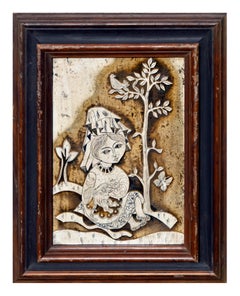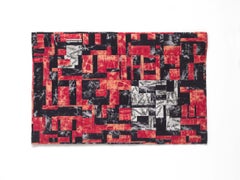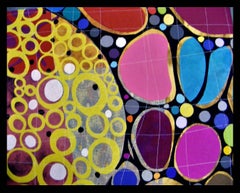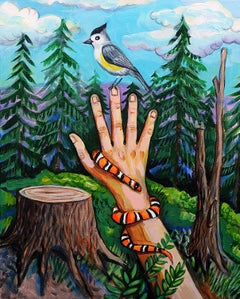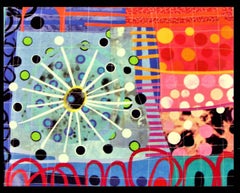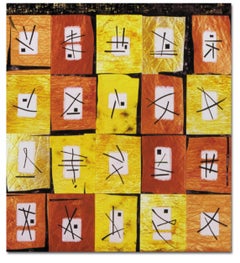Folk Art More Art
1960s Folk Art More Art
Marble
2010s Folk Art More Art
Fabric
2010s Folk Art More Art
Fabric
Artist Comments
A whimsical, folk art style painting of nature interacting with a human in the forest. A snake wraps itself around the outstretched hand while a cardinal rest...
21st Century and Contemporary Folk Art More Art
Acrylic
2010s Folk Art More Art
Fabric
Early 2000s Folk Art More Art
2010s Folk Art More Art
Fabric
2010s Folk Art More Art
Fabric
Late 19th Century Folk Art More Art
Wool
1950s Folk Art More Art
Wool
1960s Folk Art More Art
Fabric, Cotton
20th Century Folk Art More Art
Fabric, Wool
20th Century Folk Art More Art
Mixed Media
1940s Folk Art More Art
Fabric, Glass, Found Objects
Early 2000s Folk Art More Art
Paper, Acrylic, Pencil
20th Century Folk Art More Art
Mixed Media, Polaroid
20th Century Folk Art More Art
Wool
Mid-20th Century Folk Art More Art
Wool, Textile, Organic Material
20th Century Folk Art More Art
Wool, Felt
2010s Folk Art More Art
Textile
1860s Folk Art More Art
Wool
Artist Comments
A pansy opens up, luring the viewer's gaze towards its center. Against the dark background, the deep mauve tones of the flower stand out, highlighting its del...
21st Century and Contemporary Folk Art More Art
Oil
20th Century Folk Art More Art
Mixed Media
20th Century Folk Art More Art
Mixed Media
Late 20th Century Folk Art More Art
Tapestry
Artist Comments
Artist Sharon Sieben presents a woman assuming a confident stance and comfortability with the status quo. "It is a good thing to take an occasional time out t...
21st Century and Contemporary Folk Art More Art
Acrylic
1960s Folk Art More Art
Fabric
Late 20th Century Folk Art More Art
Wood, Paint
Early 1600s Folk Art More Art
Textile, Wood
Artist Comments
A nude woman sits in an affecting posture, demonstrative of her feelings. Artist Sharon Sieben presents the expressive portrait evoking raw and powerful emotions. Her bold brushwork reveals an articulate and deep narrative. Sharon paints with strong strokes to create dynamic textures in the background.
About the Artist
Sharon Sieben prefers working in a loose, fluid technique and finds inspiration in the most unexpected things. Her parents bought her a set of oil paints when she was ten years old and it sparked her love of art. She especially admires the work of Impressionist artists such as Paul Cezanne because of how they broke tradition. When she's not making art, she enjoys reading and playing classical guitar...
21st Century and Contemporary Folk Art More Art
Acrylic
Early 20th Century Folk Art More Art
Cotton, Silk, Thread
20th Century Folk Art More Art
Tapestry
Mid-19th Century Folk Art More Art
Wool
Artist Comments
Artist Pamela Hoke displays a closeup of the large leaves and spiny tips of a giant Agave. The piece evokes a simply enchanting cal...
21st Century and Contemporary Folk Art More Art
Oil
20th Century Folk Art More Art
Paint, Mixed Media, Photographic Paper
2010s Folk Art More Art
Textile
Artist Comments
I have a succulent in a ceramic sugar skull pot in my kitchen and painted it from life. It has a wonderful expression on its face, and I enjoy the spikey succulent growing from the top like hair.
About the Artist
Kira Yustak paints fantastical scenes that come from her childhood memories, dreams, and the natural world. Each piece feels like part of a larger narrative of an alternative reality, rendered in a style she describes as comic realism. She feels art must trigger something inside the viewer’s soul.Kira currently lives in New Jersey and finds inspiration in the work of Lowbrow, Folk, and Surrealist artists.
Words that describe this painting: sugar skull, cactus, houseplant, garden, plants, day of the dead, succulent, still life, still life, representational, primitive, acrylic painting, green
21st Century and Contemporary Folk Art More Art
Acrylic
20th Century Folk Art More Art
Mixed Media
20th Century Folk Art More Art
Tapestry
2010s Folk Art More Art
Textile
2010s Folk Art More Art
Wool, Cotton
2010s Folk Art More Art
Textile
Mid-20th Century Folk Art More Art
Cotton
2010s Folk Art More Art
Textile
Mid-20th Century Folk Art More Art
Textile
2010s Folk Art More Art
Textile
Mid-20th Century Folk Art More Art
Paint
Mid-19th Century Folk Art More Art
Wool
1860s Folk Art More Art
Wool
1860s Folk Art More Art
Ceramic
Mid-19th Century Folk Art More Art
Wool
1860s Folk Art More Art
Wool
Early 20th Century Folk Art More Art
Paint
1860s Folk Art More Art
Wool
Mid-20th Century Folk Art More Art
Wool, Textile, Organic Material
Mid-19th Century Folk Art More Art
Wool
2010s Folk Art More Art
Wood, Lacquer
20th Century Folk Art More Art
Mixed Media
2010s Folk Art More Art
Wood, Lacquer
2010s Folk Art More Art
Wood, Lacquer
